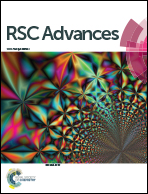Self-reduction and morphology control of gold nanoparticles by dendronized poly(amido amine)s for photothermal therapy†
Abstract
Worm-like carboxylated 3.5 generation dendronized poly(amido amine) (DPG3.5-COOH) was applied to synthesize gold nanoparticles (AuNPs), in which process DPG3.5-COOH played the roles of reducing agent and template. The morphology of AuNPs, e.g., nanorods and nanoparticles, could also be controlled by the interior-template function or the exterior-template function of DPG3.5-COOH at different pH values. The obtained AuNPs had low cytotoxicity, effective cellular uptake and strong photothermal therapy capability for HeLa cancer cells. Therefore, the AuNPs prepared using the worm-like dendronized polymer provide a new and effective approach for photothermal therapy.


 Please wait while we load your content...
Please wait while we load your content...